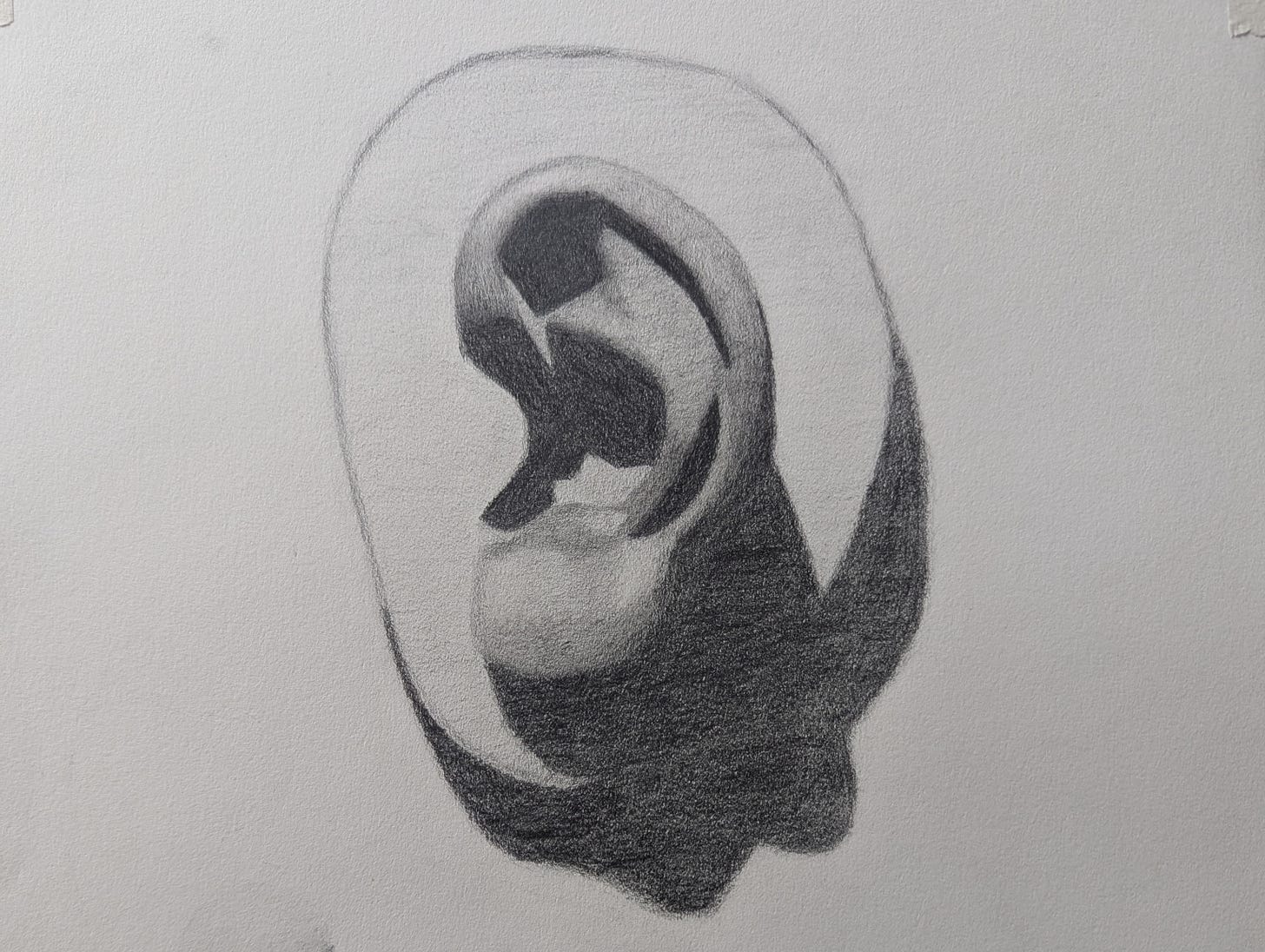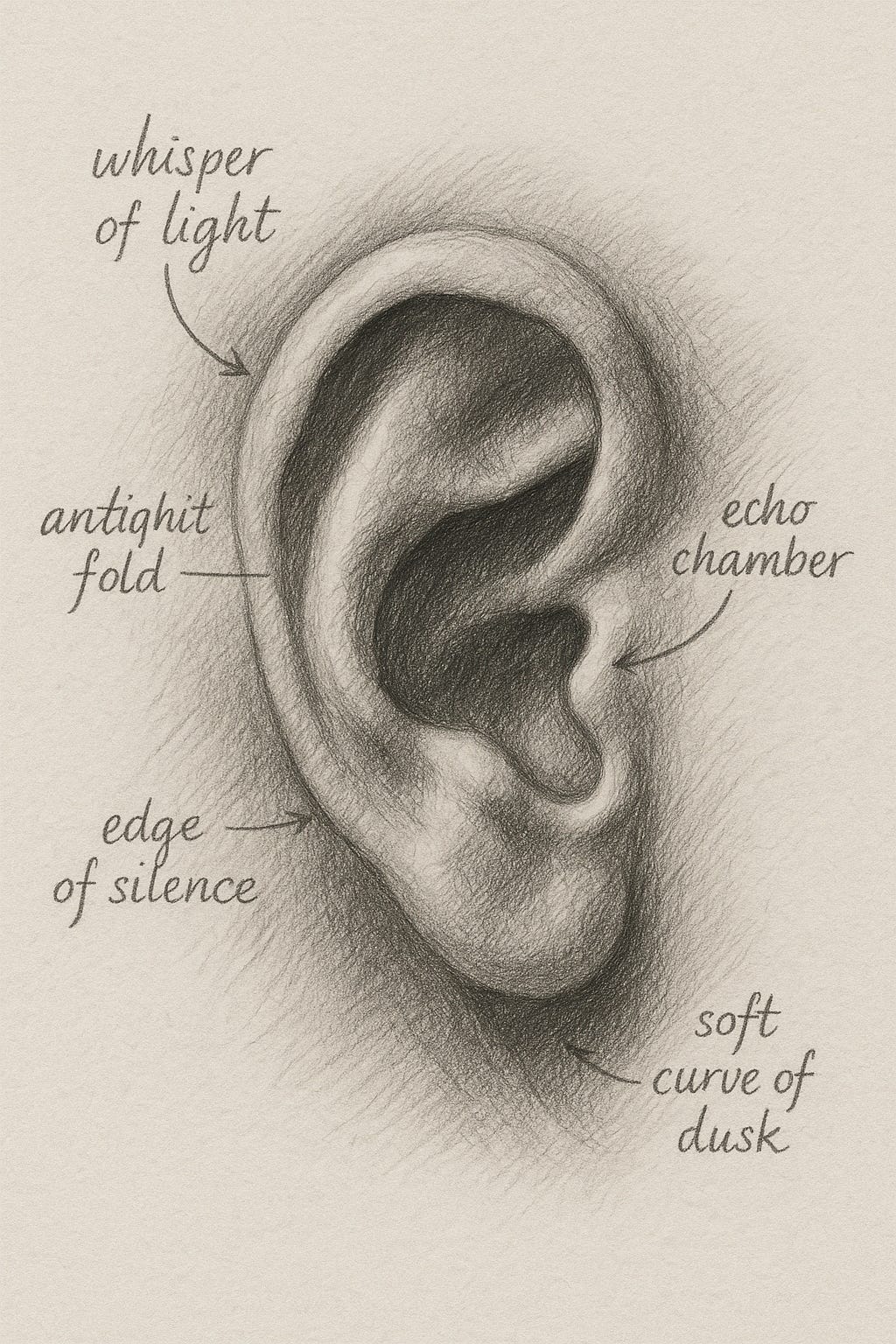I just spent a week up in Hudson, NY. Beautiful town. It afforded me a great opportunity to reflect about the role that art plays in my life and how the AI revolution is impacting it. I wrote this article a while back but luckily hadn’t gotten around to publishing it. I feel now is the right time as I have had a chance to sharpen the focus on what I really think about this. I hope you enjoy it.
What is Drawing?
Is it graphite on paper?
A likeness?
A feeling, frozen in line and shadow?
Or is it, at its core, just information?
As I spent 15 hours in a drawing class in New York City, slowly carving an ear out of darkness with nothing but pencil and persistence, I realized something I wasn’t expecting.
Drawing is data. Carefully collected. Deliberately mapped.Light. Dark. Edge. Curve. Texture. Tone. Each one a variable. Each one telling a story. Together, they shape something we feel before we understand.
So what makes that drawing art?
It moves us. It compresses hours of observation and hundreds of micro-decisions into one still, silent image. You don’t just look at it—you sense it. And yet it’s structured. Precise. Encoded.
Just like good data.
When Data Transcends Utility
We’re trained to see data as dry charts, tables, forecasts, dashboards. But that’s only when data is treated like a transaction—meant to inform.
But what if we saw data like a painter sees a canvas?
Patterns become compositions.
Outliers become focal points.
Uncertainty becomes shadow—softening the edge, adding mystery.
Data is not just what we know—it’s also what we feel when that knowledge connects.
Just like a poem, a dance, or a painting, a beautiful dataset tells us something deeper than its individual parts. It reveals relationships. It builds trust. It sparks curiosity. It makes us pause.
Proof by Pencil

In that same art class, as I stared at a reference ear and tried to translate it faithfully to paper, I realized: drawing is just slow, manual data transformation.
Observation is data collection.
Sketching is prototyping.
Shading is iteration.
Refinement is analysis.
And yet, no one would say a drawing isn’t creative. No one would say it’s not art. Even when it’s methodical. Especially when it’s methodical.
But let me take you deeper into that moment.
Learning to Look
When I first walked into the drawing class, I was quietly apprehensive. I didn’t know if I had “the eye” or the technique. There was this unspoken pressure—will I get it right? Will I embarrass myself?
But our instructor, trained in the meticulous atelier tradition, didn’t start with tools. She started with sight.
Before we even touched our pencils, she taught us how to look. Not glance. Not assume. Look. Observe. Digest.
We studied shadows as if they were code. We tracked contours with the intensity of cartographers mapping a new coastline. Every ridge, every dip in the ear’s cartilage was a data point—an entry in the visual ledger of form.
Only after that did we move to the first step: blocking in shaded values. Then window shading, filling in tones to slowly carve out volume. And finally, the long, meditative stage of refinement—where the drawing began to breathe.
That ear, which started as a blur of doubt, began to emerge as something tangible. And through that process, I understood something profound: drawing isn’t about putting something on the page—it’s about pulling something out of observation.
It’s not unlike working with data.
You don’t just throw numbers on a chart. You look. You wait. You understand. And then you create something that reveals more than it conceals.
The Shape of Feeling
This is where the boundary between data and art gets beautifully blurry: both are systems for encoding human experience.
Artists use color, shape, rhythm, and gesture to express something internal. Data designers use axes, dimensions, color scales, and geometry to express something external.
But both are trying to connect.
An ink wash portrait can say what a bio never could. A well-designed heatmap can say what an article never does.
And when data moves us—when a chart breaks our heart or opens our eyes—it’s because someone approached it like an artist. With care. With feeling. With intent.
Seeing is Not Knowing
The fundamental lesson was a shift in perspective. The techniques and make making are essential but fall flat without the ability to observe.
We don’t actually see the world. Not really. We see what we expect. Our brains fill in the rest. We filter and flatten to make sense. Art, like good data work, is an act of resisting that reflex. It’s about learning to see with clarity and with intention. And once you do, you begin to see everything differently:
That billboard is a visual hierarchy experiment.
That weather map is a story in gradients.
That chart is a design challenge.
Everything becomes a canvas. Every image, every dashboard, every sketch, a lens through which to reveal something hidden. Even something as simple as the humble heat-map becomes a kind of mirror, reflecting both the structure of data and the texture of human thought.
Enter Gen-AI: Machine as Artist, Data as Muse
Reflecting on my earlier thoughts in Ghibli with a Prompt – Right or Wrong?, where I grappled with the implications of AI emulating beloved artistic styles, I've come to see these tools not as replacements but as collaborators. This deepening of my earlier reflections underscores how important intentionality and authenticity are in the creative process—especially when new tools invite us to explore ideas in different forms.
In a time when AI-generated content floods our screens and sparks debate over authorship and authenticity, the need to look more deeply—to see the data behind the beauty—has never felt more urgent.
They’re interpreting, not just computing. Today’s AI tools learn aesthetic logic, emotional cadence, and visual rhythm. They can translate data into evocative media.
Ask Midjourney v6 to render a quiet forest at dusk, and it doesn’t return clipart but it gives you a mood. Mist curling at the base of trees. Light diffused like memory.
Use Google Veo or Runway Gen-3 Alpha to generate cinematic video sequences from nothing but text. The result? Narrative. Camera moves. Lighting shifts. Emotion.
as an example, I created the video below to convey something I had seen on a rainy morning on my way to the coffeeshop
AI magnifies human creativity. It echoes our curiosity back to us in pixels and sound.
But it also challenges us.
It demands that we rethink authorship, intuition, and the invisible line between creation and curation. In some ways, AI forces us to look at ourselves as artists and engineers—creators who build and train systems that can surprise us.
And when done well, AI-generated content doesn’t feel cold or synthetic. It feels resonant—sometimes even profound. They are products of design decisions, human prompting, and machine interpretation converging into something emotionally legible.
Why? Because it follows the same hidden logic: information crafted with care becomes something that moves us.

What is art? what is data? are they intertwined?
Does it help us see? Does it help us feel? Does it help us understand?
That’s the sweet spot.
Because in the end, art is data that moves us.
And data, when crafted with care, becomes a form of art.
Have you ever made something that blurred the line between art and information? A chart, a sketch, a system? Maybe even a generative image or AI-aided video edit? I’d love to hear your story, drop it in the comments below.





Such a thought provoking article!!! Enjoyed reading it very much…